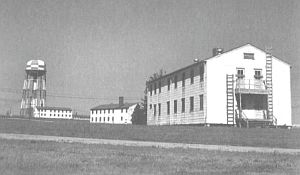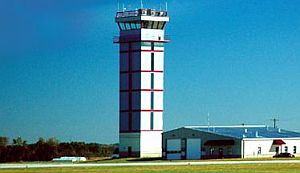Donaldson Center Industrial Air Park (now SC Aviation and Technology Center) was originally a military air base established in the early 1940s by the US War Department at Greenville, South Carolina as a new air base to support the US build-up for World War Two. The airfield was built in a 2,600-acre property located 11 km south of the center of the city.
The base was completed in May 1942, and in June, Greenville Army Air Base was officially activated as a training base for replacement aircrews. The first units to arrive in August were the B-24's of the 90th Heavy Bomb Group and the B-25's of the 334th Bombardment Group. The 90th stay was short-lived as they were sent to the Pacific Theater immediately, but the 334th stayed on through the course of the war to train replacement B-25 aircrews.

At the end of 1945, after WWII ending the base was first placed on standby status and then progresivelly transitioned from aircrew training to a military airlift mission, playing an instrumental role in the Berlin Airlift, among other post-war operations.
With the onset of the Korean War, the base (then Greenville Air Force Base) became home to the 375th & 433rd Troop Carrier Wings, flying the C-119 "Boxcar" as well for the 63rd Troop Carrier Wing aircrews flying the large C-124 "Globemaster" transports. In 1951, the base was again renamed Donaldson Air Force Base, in honor of Captain John O. Donaldson, a Greenville native and World War I flying ace. By that time it was one of the busiest spots for the Air Force, performing global missions that touched every corner of the world from Europe to Asia, and from the Far East to the ice runways of Antarctica. During that times several improvements were performed including the construction of hangars and expansive ramps to support the large aircraft operating there.
In December 1962, the Air Force announced plans to close the base permanently. Donaldson was declared surplus in 1963 and steps were taken to deed the property back to the City and County of Greenville. The return to civilian hands was materialized on January 25, 1964 along with a further denomination change of the facility as Donaldson Center Industrial Air Park.
Balloons

In the early 80's the National Scientific Balloon Facility (NSBF) which operated all balloons launched under the aegis of the NASA balloon program, found that during periods of low stratospheric winds (turnaround) the launch activity at their stations intensified as a result of the large number of scientific groups that had requirements to perform flights with durations of 24 hours or longer. Thus, to offer more flight opportunities to the scientific community for extended flights the NSBF conducted a field program of transcontinental balloon flights selecting Greenville as launch location because being near the east coast of the United States, the site seemed ideal to perform these long duration balloon flights in the Summer months when the prevailing winds blow westward.
Full telemetry and command coverage during the flight was offered from ground stations installed at the launch site at Donaldson, as well the main NSBF base in Palestine, and a station provided by NASA in Lubbock, Texas.
Some isolated flights during 1979 and 1981 were followed by a full fledged campaign carried out in 1982 which included the launch of six of the biggest balloons available at the time. The balloons moved to the western states and after reaching suitable landing areas were terminated either in New Mexico or Arizona, achieving flight times of up to 60 hours.
The 1982 campaign was at the same time the biggest NASA operation at the site and the last one. Since then no balloons were launched from Donaldson.
Nowadays the entire facility is the largest general aviation airport in the state and serves a vital role as a major aircraft maintenance and modification center.
Table of balloons launched from Donaldson Industrial Air Park
| Date | Hour | Flight Duration | Experiment | Payload landing place or cause of the failure |
|---|---|---|---|---|
| 8/17/1979 | F 46 h | SKY ANCHOR X | Near Las Vegas, Nevada, US | |
| 9/9/1981 | F 45 h | SKY ANCHOR XIII | --- No Data --- | |
| 5/29/1982 | 10:36 utc | 64 h 20 m | X-RAY / GAMMA RAY EXPERIMENT | 22 miles N of Winslow, Arizona, US |
| 6/2/1982 | 23:41 utc | 47 h | JACEE 3 (Japanese-American Collaborative Emulsion Experiment) | 28 miles E of Roswell, New Mexico, US |
| 6/6/1982 | --- | --- | HIGH RESOLUTION SPECTROMETER | Ground abort due to high winds |
| 6/10/1982 | 12:16 utc | F 33 h 10 m | HIGH RESOLUTION SPECTROMETER | 25 miles NW of El Paso, Texas, US |
| 6/14/1982 | 0:16 utc | 49 h 50 m | COSMIC RAY EXPERIMENT | 15 miles W of Fort Sumner, New Mexico, US |
| 6/23/1982 | 12:12 utc | 11 h 55 m | GRYOGENIC GAS REPLENISHMENT TEST FLIGHT | 20 miles N of Toccoa, Georgia, US |
| 5/28/1983 | 12:24 utc | --- | X-RAY EXPERIMENT | 15 miles NE of Florence, Alabama, US |
| 6/11/1983 | 00:13 utc | --- | X-RAY EXPERIMENT | 13 miles N of Ada, Oklahoma, US |
If you consider this website interesting or useful, you can help me to keep it up and running with a small donation to cover the operational costs. Just the equivalent of the price of a cup of coffee helps a lot.

